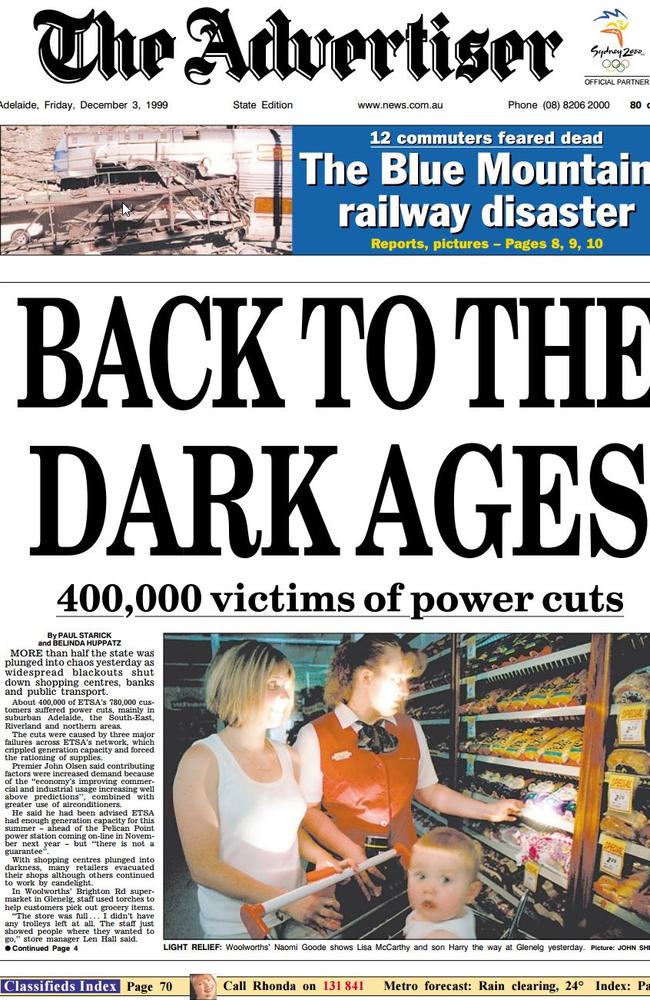A blast from South Australia’s blackout past
SEVENTEEN years ago today, all South Australia was talking about a massive blackout that affected half the state. Sound familiar?
National
Don't miss out on the headlines from National. Followed categories will be added to My News.
THERE seems to be three certainties for South Australians: life, death and blackouts.
A quick dive into The Advertiser’s archives has revealed the power outage on December 1 was not the first time South Australia has experienced electricity issues heading into bushfire season.
More than half of the state was left without a light after three massive failures across the former state-owned ETSA network 17 years ago.

Here’s how The Advertiser reported it:
“About 400,000 of ETSA’s 780,000 cus tomers suffered power cuts, mainly in suburban Adelaide, the Southeast, Riverland and northern areas.
The cuts were caused by three major failures across ETSA’s network, which crippled generation capacity and forced the rationing of supplies.
Premier John Olsen said contributing factors were increased demand because of the ‘‘economy’s improving commer cial and industrial usage increasing well -above predictions’’, combined with greater use of airconditioners.
He said he had been advised ETSA had enough generation capacity for this summer — ahead of the Pelican Point power station coming online in Novem ber next year — but ‘‘there is not a guarantee’’.”
Sound familiar?
Because it is. Here’s our blackout story on the same day 17 years later:
“The embattled State Government cannot guarantee a constant power supply during the peak bushfire season, while SA’s biggest private employer warns the energy debacle is risking jobs and investment.
After a quarter of the state — about 200,000 customers — suffered power outages on the first day of summer, Treasurer and Energy Minister Tom Koutsantonis conceded growing public concern, but argued “there was sufficient thermal, wind and solar generation to cope.”
The government may have changed but there seems to be one thing South Australia’s politicians haven’t quite figured out: How to keep the lights on.
THE STATE-WIDE BLACKOUT OF 1999
MORE than half the state was plunged into chaos yesterday as widespread blackouts shut down shopping centres, banks and public transport.
About 400,000 of ETSA’s 780,000 customers suffered power cuts, mainly in suburban Adelaide, the South-East, Riverland and northern areas.
The cuts were caused by three major failures across ETSA’s network, which crippled generation capacity and forced the rationing of supplies.
Premier John Olsen said contributing factors were increased demand because of the ‘‘economy’s improving commercial and industrial usage increasing well above predictions’’, combined with greater use of airconditioners.
He said he had been advised ETSA had enough generation capacity for this summer – ahead of the Pelican Point power station coming on-line in November next year – but ‘‘there is not a guarantee”.
With shopping centres plunged into darkness, many retailers evacuated their shops although others continued to work by candelight.
In Woolworths’ Brighton Rd supermarket in Glenelg, staff used torches to help customers pick out grocery items.
“The store was full . . . I didn’t have any trolleys left at all. The staff just showed people where they wanted to go,’’ store manager Len Hall said.
The blackout was triggered by a ‘‘flashover’’, or violent shortcircuit, at a Port Augusta substation at 1.41pm, which caused two generators from the nearby Northern Power Station to automatically disconnect from the network.
ETSA suspected lightning was to blame.
Almost immediately afterwards, the inter-connector from Victoria failed in unexplained circumstances.
The combined shutdowns caused the loss of 1000 megawatts, or 40 per cent of the state’s total load.
ElectraNet SA (the former ETSA’s transmission arm) then started the rotational load shedding, or staged blackouts, at 2pm. On average, each customer was without power for 90 minutes.
The situation was exacerbated by the failure of a generator at Torrens Island at 3.45pm.
The havoc caused by the blackouts caused:
THOUSANDS of businesses across the state to stop trading when they lost power for cash registers, lights, fridges and airconditioning.
FIVE trams on the Adelaide to Glenelg line to stop in their tracks.
EIGHTEEN city trains to stop after a power surge damaged computers controlling the suburban system, stranding hundreds of passengers, including schoolchildren.
POLICE to hold up train crossing boom gates, which had automatically closed, to allow traffic to pass.
MODBURY Hospital to cancel two operations after losing power.
FILMS in cinemas to be interrupted.
HOTELS to sell bottled beer in the dark when lights, airconditioning, beer pumps and poker machines failed.
BANKS and automatic teller machines to shut down, with BankSA temporarily shutting about 70 per cent of branches.
SHOPPING centres, including Westfield Marion and Tea Tree Plaza, to suddenly plunge into darkness when power failed.
SECURITY alarms to be acti vated across the city, straining police resources.
ABOUT 400 traffic lights, or 80 per cent of the Adelaide network, to fail, with police directing traffic at some intersections.
SEWAGE to overflow from a Hallett Cove treatment plant, forcing United Water to place hay bales to prevent it entering stormwater drains.
SA WATER to shut down the five pipelines from the River Murray, a relatively common power-saving procedure during blackouts.
TELEPHONE systems operated by electronic switchboards to fail.
The Victorian interconnector was restored about 2.10pm.
By 6pm, the power shedding had finished, after public consumption waned amid the cooler weather and in response to public alerts – but the failed generators were still not working.
ETSA business relations executive manager Craig Cock said the Victorian interconnector overloaded and shut down because of the increased demand after the Northern Power Station’s failure.
He assured the public there was enough electricity to adequately serve customers this summer.
‘‘(Customers were) very frustrated and inconvenienced at a time when they really needed their electricity,’’ he said.
‘‘The weather conditions just didn’t allow us to continue the supply of the electricity and I guess we just need to apologise for that inconvenience.’’
Originally published as A blast from South Australia’s blackout past


